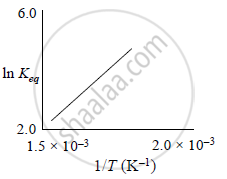Advertisements
Advertisements
प्रश्न
The rate constant of a first order reaction increases from 4 × 10−2 to 8 × 10−2 when the temperature changes from 27°C to 37°C. Calculate the energy of activation (Ea). (log 2 = 0.301, log 3 = 0.4771, log 4 = 0.6021)
उत्तर
Given:
k1 = 4 × 10−2
k2 = 8 × 10−2
T1 = 300 K
T2 = 310 K
Solution:
`log(k_2/k_1)=E_a/(2.303R)[(T_2-T_1)/(T_1T_2)]`
`log((8xx10^(-2)|)/(4xx10^(-2)))=E_a/(2.303R)[(T_2-T_1)/(T_1T_2)]`
`0.301= E_a/(2.303xx 8.314JK^(-1)mol^(-1))[(310-300)/(310xx300)]`
`E_a=(0.301 × 2.303 × 8.314 × 93000)/10`
Ea = 53598.5 J
APPEARS IN
संबंधित प्रश्न
Explain a graphical method to determine activation energy of a reaction.
A first-order reaction is 50% completed in 40 minutes at 300 K and in 20 minutes at 320 K. Calculate the activation energy of the reaction. (Given : log 2 = 0·3010, log 4 = 0·6021, R = 8·314 JK–1 mol–1)
Explain the following terms :
Half life period of a reaction (t1/2)
Which of the following statements are in accordance with the Arrhenius equation?
(i) Rate of a reaction increases with increase in temperature.
(ii) Rate of a reaction increases with decrease in activation energy.
(iii) Rate constant decreases exponentially with increase in temperature.
(iv) Rate of reaction decreases with decrease in activation energy.
Thermodynamic feasibility of the reaction alone cannot decide the rate of the reaction. Explain with the help of one example.
In respect of the eqn k = \[\ce{Ae^{{-E_a}/{RT}}}\] in chemical kinetics, which one of the following statement is correct?
The rate constant for a reaction is 1.5 × 10–7 sec–1 at 50°C. What is the value of activation energy?
A schematic plot of ln Keq versus inverse of temperature for a reaction is shown below

The reaction must be:
A first-order reaction is 50% complete in 30 minutes at 300 K and in 10 minutes at 320 K. Calculate activation energy (Ea) for the reaction. [R = 8.314 J K−1 mol−1]
[Given: log 2 = 0.3010, log 3 = 0.4771, log 4 = 0.6021]
It is generally observed that the rate of a chemical reaction becomes double with every 10oC rise in temperature. If the generalisation holds true for a reaction in the temperature range of 298K to 308K, what would be the value of activation energy (Ea) for the reaction?
